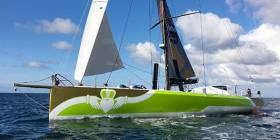Displaying items by tag: Kilcullen
Tickets on Sale for Howth K25s’ Kilcullen Fundraising Dinner With Special Guest Enda O’Coineen
Howth Yacht Club’s K25 Keelboat Squad have announced an upcoming fundraising dinner at the club on Friday 3 March to support their 2023 racing campaign in their beloved Kilcullen.
Guests will be treated to a star-studded evening, filled with delicious food, great company and a prize raffle, not to mention special guest speaker Enda O'Coineen — a long-time supporter of the squad, accomplished racing sailor and founder of the Atlantic Youth Trust.
Enda will share his experiences and insights on the sport of sailing, as well as his thoughts on the importance of supporting young sailors.
Tickets for the event at 7.30pm next Friday 3 March are €60 each and are available HERE.
Ireland' first ever Vendee Globe entry having undergone a refit in France and repaint, with distinctive 'Claddagh ring' decal on the bow, has docked in Kinsale instead of its intended port of Galway because of gear failure on a trip from France.
It means O'Coineen's KIlcullen Team Ireland’s arrival into Galway has been delayed until mid next week. Near gale force headwinds on the trip from France resulted in a shroud becoming loose putting the mast at risk. With just 93 days until the start of the Vendee Globe the crew aired on the side of caution and called into Kinsale in County Cork.
It is hoped the Team will depart early next week for the final leg to Galway. After a short stay in Galway Docks the plan is for the Team’s Skipper Enda O’Coineen to go out into the Atlantic Ocean for a weeks training. An around the world send off is then provisionally planned for Sunday evening 21 August on the Galway Docks.
The traditional Irish Claddagh ring symbol features two hands clasping a heart, surmounted by a crown. The elements of this symbol are often said to correspond to the qualities of love (the heart), friendship (the hands), and loyalty (the crown).























